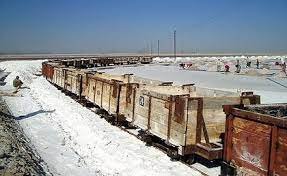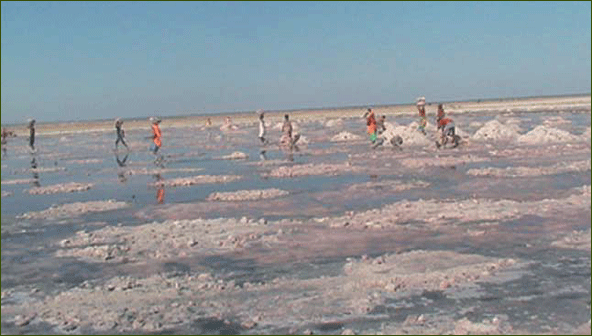Sambhar Lake is India’s largest inland saltwater lake, located in the state of Rajasthan. The lake covers an area of approximately 190 square kilometers and is situated at an altitude of 371 meters above sea level. The lake is surrounded by the Aravalli Hills and is fed by five major rivers and numerous small streams.
Sambhar Lake is a crucial habitat for a variety of migratory birds, including flamingos, pelicans, storks, and cranes. It is also a significant source of salt for the region, with salt pans and salt extraction being the primary activities in the area.
The lake has a rich cultural history, with evidence of human habitation dating back to the 4th millennium BCE. It was an important center of trade and commerce during the Mauryan and Gupta empires and was later ruled by the Rajputs and Mughals.
Today, Sambhar Lake is a popular tourist destination, with visitors coming to witness the stunning natural beauty of the area, observe the diverse birdlife, and learn about the local culture and history. The lake is easily accessible from Jaipur, the capital city of Rajasthan, and is a must-visit destination for nature and history enthusiasts.
History of Sambhar Lake
Sambhar Lake has a rich and fascinating history that spans several millennia. Archaeological evidence suggests that human habitation in the area dates back to the 4th millennium BCE, with the region being an important center of trade and commerce during the Mauryan and Gupta empires.
In the medieval period, Sambhar Lake was ruled by the Rajputs, who were known for their military prowess and patronage of the arts. The lake was a crucial source of salt, which was a valuable commodity in those times, and the Rajputs developed sophisticated techniques for salt production and trade.
During the Mughal period, Sambhar Lake continued to be an important center of salt production and trade, and the Mughal emperors recognized its strategic and economic significance. The lake was also a popular hunting ground for the Mughal royals, who would come here to hunt deer, antelope, and other wild animals.
In the 19th century, the British took over the administration of Sambhar Lake and introduced modern techniques for salt production and trade. They also built a railway line connecting Sambhar Lake to nearby cities, making it easier to transport salt and other goods.
Today, Sambhar Lake is a popular tourist destination, known for its natural beauty, diverse birdlife, and rich cultural heritage. It continues to be an important center of salt production, with the local communities relying on it for their livelihoods.
Best Attraction of Sambhar Lake

The primary attraction of Sambhar Lake is undoubtedly its mesmerizing birdlife. The lake serves as a haven for a diverse range of avian species, making it a paradise for birdwatchers and nature enthusiasts. Witnessing the vast flocks of flamingos, pelicans, storks, and various waders in their natural habitat is a truly awe-inspiring experience.
The sheer number and variety of birds that visit Sambhar Lake during the winter months make it a unique and significant destination for birdwatching. The sight of these magnificent creatures against the backdrop of the serene lake is a sight to behold and offers ample opportunities for bird photography.
Apart from birdwatching, Sambhar Lake also offers picturesque landscapes and stunning sunsets, making it a scenic location for nature lovers. The vast expanse of the salt pans and the surrounding arid terrain create a distinct and captivating atmosphere.
Additionally, the cultural and historical significance of the region adds to its allure. The nearby Salt Processing Plant and Salt Museum provide insights into the salt production industry and the traditional practices associated with it. Exploring these sites offers a deeper understanding of the local culture and heritage.
Overall, the best attraction of Sambhar Lake lies in its combination of breathtaking birdlife, stunning natural landscapes, and a glimpse into the region’s cultural heritage. Whether you are a bird enthusiast, a nature lover, or someone interested in local traditions, Sambhar Lake offers a memorable and enriching experience.
Architecture of Sambhar Lake
Sambhar Lake is primarily known for its natural beauty and cultural significance, rather than for any specific architectural landmarks. However, there are a few notable architectural features in the surrounding area that are worth mentioning.
One of the most impressive architectural features near Sambhar Lake is the Salt Lake Palace, which was built in the early 20th century by the then ruler of Sambhar, Maharaja Man Singh II. The palace was designed by British architect Samuel Swinton Jacob and is a fine example of the Indo-Saracenic architectural style. It features a mix of Indian and European architectural elements, including intricate carvings, arches, and domes. Today, the palace is mostly in ruins, but it remains a popular tourist attraction.
Another architectural feature of note in the area is the Naliasar Jain Temple, which is located about 25 kilometers from Sambhar Lake. The temple is dedicated to Lord Parshwanath, a Jain Tirthankar, and features intricate carvings and sculptures. The temple dates back to the 10th century and is one of the oldest Jain temples in Rajasthan.
Finally, there are several ancient ruins in the surrounding area, including the ruins of the Sambhar Fort, which was built in the 14th century by the Chauhan Rajputs. The fort is now mostly in ruins, but it remains a popular attraction for history enthusiasts.
While the architectural features in the area may not be as prominent as those in other parts of India, they nonetheless offer a fascinating glimpse into the rich cultural and historical heritage of Sambhar Lake and its surroundings.
Salt Processing Plant & Salt Museum
The Salt Processing Plant and Salt Museum at Sambhar Lake in Rajasthan, India, are key attractions that provide insights into the salt production industry and the cultural significance of the region.
The Salt Processing Plant showcases the modern methods and technology employed in the processing of salt extracted from Sambhar Lake. Visitors can observe the various stages involved in salt production, including purification, drying, and packaging. It offers a glimpse into the industrial aspect of salt production, highlighting the advancements made in the field.
Salt Train of Sambhar Lake

The Salt Train of Sambhar Lake is a remarkable sight, showcasing the unique transportation of salt from the expansive salt pans surrounding the lake, offering a glimpse into the salt production industry and the vibrant culture of the region.
The Salt Train of Sambhar Lake in Rajasthan, India, is a traditional method of transporting salt from the salt pans to processing plants or storage depots. Workers manually pull a series of narrow-gauge rail carts loaded with salt along the railway tracks. This labor-intensive process is conducted year-round, showcasing the region’s cultural heritage and the dedication of the local communities involved in salt production. The Salt Train offers a captivating and authentic experience for visitors, providing insight into the traditional salt industry and the significance of Sambhar Lake in Rajasthan’s economy.
Facilities at Sambhar Lake
Sambhar Lake is a popular tourist destination, and there are several facilities available for visitors to make their trip comfortable and enjoyable.
Accommodation: There are several hotels, resorts, and guesthouses available near Sambhar Lake that cater to different budgets and preferences. These accommodations offer comfortable rooms, delicious food, and various amenities to make your stay pleasant.
Transportation: Sambhar Lake is well-connected to nearby cities like Jaipur and Ajmer by road and rail. You can hire a taxi or take a bus to reach the lake. Additionally, there are several tour operators who offer guided tours of the area.
Activities: Sambhar Lake is a bird-watcher’s paradise, and visitors can witness a wide variety of migratory and resident bird species. You can also take a camel safari to explore the surrounding area or visit nearby historical sites like the Salt Lake Palace or the Naliasar Jain Temple.
Food and Drink: There are several restaurants and food stalls in the area that serve local delicacies like dal-bati-churma, gatte ki sabzi, and Rajasthani thali. Additionally, there are several shops that sell salt and other local products.
Medical Facilities: There are several medical facilities available near Sambhar Lake, including hospitals and clinics. It is always advisable to carry your own first aid kit and any necessary medication with you.
Overall, Sambhar Lake offers a comfortable and enjoyable experience for visitors, with several facilities available to make your trip memorable.
Facts About Sambhar Lake
Here are some interesting facts about Sambhar Lake:
- Sambhar Lake is the largest salt lake in India, covering an area of about 190 square kilometers.
- The lake is located in the state of Rajasthan, about 80 kilometers from the state capital, Jaipur.
- The lake is a popular bird-watching destination, with over 200 species of birds recorded here, including flamingos, pelicans, and cranes.
- Sambhar Lake is an important source of salt, with annual production of around 1.5 million tons.
- The lake is surrounded by several ancient temples and forts, including the Salt Lake Palace, the Naliasar Jain Temple, and the ruins of the Sambhar Fort.
- The lake is a Ramsar site, which means it is recognized as a wetland of international importance.
- Sambhar Lake is believed to have been formed by a meteorite impact about 5,000 years ago.
- The lake has a maximum depth of about 3 meters and is fed by several seasonal streams.
- The lake is a unique ecosystem, with several species of halophytic (salt-tolerant) plants and animals that have adapted to the high salt levels in the water.
- Sambhar Lake has been the site of several cultural and historical events, including the legendary battle between the Rajput king Prithviraj Chauhan and the invading Muslim army of Muhammad Ghori in the 12th century.
Tips For Memorable Visit to Sambhar Lake
Here are some tips to make your visit to Sambhar Lake a memorable one:
- Plan your visit during the winter months (October to March), as this is the best time to see migratory birds and enjoy the pleasant weather.
- Wear comfortable clothing and footwear, as you may need to walk or hike around the lake or nearby areas.
- Carry sunscreen, sunglasses, and a hat to protect yourself from the harsh sun.
- Carry a pair of binoculars and a camera to observe and capture the unique flora and fauna of the lake.
- Be respectful of the local culture and traditions, and dress modestly when visiting temples or other religious sites.
- Carry sufficient water and snacks, as there may not be many shops or restaurants in the area.
- If you plan to visit the Salt Lake Palace or other historical sites, hire a local guide to learn more about the history and significance of these places.
- Try local Rajasthani cuisine, especially the traditional dishes like dal-bati-churma, gatte ki sabzi, and Rajasthani thali.
- Avoid visiting the lake during the monsoon season (June to September), as the lake may overflow and become dangerous.
- Do not litter or disturb the natural environment of the lake, and respect the local flora and fauna.
How To Reach Sambhar Lake
Sambhar Lake is located in the state of Rajasthan, India. Here are the different ways to reach Sambhar Lake:
By Air: The nearest airport to Sambhar Lake is Jaipur International Airport, which is about 85 kilometers away. From the airport, you can hire a taxi or take a bus to reach Sambhar Lake.
By Train: Sambhar Lake has a railway station on the Jaipur-Ajmer railway line, which is connected to major cities like Delhi, Mumbai, and Kolkata. From the railway station, you can hire a taxi or take a local bus to reach the lake.
By Road: Sambhar Lake is well-connected by road to nearby cities like Jaipur and Ajmer. You can take a bus or hire a taxi from these cities to reach Sambhar Lake.
By Self-Drive: You can also drive to Sambhar Lake from Jaipur, which takes about 2 hours. The route is well-paved, and there are several petrol pumps and restaurants on the way.
Lesser Known Facts about Sambhar Lake
- Sambhar Lake is not just a saltwater lake, but also a freshwater lake. The lake has several freshwater springs and streams that flow into it.
- Sambhar Lake is home to several species of migratory birds, including the Northern Shoveler, Ruff, and Kentish Plover.
- The lake is also home to several species of fish, including the Indian Carp, Rohu, and Catfish.
- The salt extracted from Sambhar Lake is used for various purposes, including food preservation, tanning leather, and making soap.
- The lake has several islands, some of which are home to ancient temples and shrines.
- The area around Sambhar Lake is rich in minerals and has several salt mines, gypsum mines, and limestone quarries.
- Sambhar Lake is surrounded by several small villages, where you can experience the local Rajasthani culture and cuisine.
- The lake has been the site of several Bollywood movie shoots, including the film “Peepli Live.”
- Sambhar Lake has a unique ecosystem, with several species of halophytic plants that have adapted to the high salt levels in the soil.
- The lake has a high level of salinity, which makes it a popular destination for salt farming and salt harvesting.
Places To Stay Near Sambhar Lake
Sambhar Lake has several options for accommodation, ranging from budget guesthouses to luxury resorts. Here are some of the best places to stay in Sambhar Lake:
- The Sambhar Heritage Resort: This is a luxury resort located near the lake and offers comfortable rooms, a swimming pool, a spa, and a restaurant serving Rajasthani cuisine.
- Sambhar Lake Camps: This is a unique camping experience that offers comfortable tents with attached bathrooms, outdoor seating areas, and bonfire pits.
- Sambhar Lake Palace: This is a heritage hotel located on the banks of the lake and offers comfortable rooms, a restaurant serving Indian and Continental cuisine, and a swimming pool.
- Royal Safari Camps: This is another camping option that offers luxurious tents with attached bathrooms, air conditioning, and outdoor seating areas.
- Sambhar Resort and Spa: This is a budget-friendly resort that offers comfortable rooms, a swimming pool, and a restaurant serving Indian and Continental cuisine.
- Hotel Roop Vilas Palace: This is a heritage hotel located near the lake and offers comfortable rooms, a restaurant serving Rajasthani cuisine, and a swimming pool.
- Hotel Mangaldeep Palace: This is a budget hotel located near the lake and offers comfortable rooms, a restaurant serving Indian and Chinese cuisine, and a swimming pool.
- It is advisable to book your accommodation in advance, especially during the peak tourist season (October to March) to avoid any last-minute hassles.
Places to Visit NearSambhar Lake Within 10 km
There are several places to visit within 10 km of Sambhar Lake. Here are some of the most popular ones:
- Devyani Salt Works: This is a salt-processing unit located near Sambhar Lake and offers a fascinating insight into the process of salt harvesting.
- Shakambari Temple: This is an ancient temple located near Sambhar Lake and is dedicated to the goddess Shakambari.
- Sambhar Wildlife Sanctuary: This is a protected area located near Sambhar Lake and is home to several species of birds, including flamingos, pelicans, and storks.
- Naliasar Lake: This is a freshwater lake located near Sambhar Lake and is a popular spot for birdwatching and picnicking.
- Jhakhand Mahadev Temple: This is an ancient temple located near Sambhar Lake and is dedicated to Lord Shiva.
- Sambhar Salt Museum: This is a museum located near Sambhar Lake and showcases the history of salt production in the region.
- Khandela Haveli: This is a heritage hotel located near Sambhar Lake and offers a glimpse into the rich cultural heritage of Rajasthan.
- Ramdwara Temple: This is an ancient temple located near Sambhar Lake and is dedicated to Lord Rama.
- Maha Kali Temple: This is a famous temple located near Sambhar Lake and is dedicated to the goddess Kali.
These places are easily accessible from Sambhar Lake and can be visited in a day trip.
Frequently Asked Questions about Sambhar Lake
Sure, here are some frequently asked questions about Sambhar Lake along with their answers:
Q: Where is Sambhar Lake located?
A: Sambhar Lake is located in the state of Rajasthan, India.
Q: What is the size of Sambhar Lake?
A: Sambhar Lake is the largest saltwater lake in India, covering an area of around 190 square kilometers.
Q: What is the best time to visit Sambhar Lake?
A: The best time to visit Sambhar Lake is between October and March when the weather is pleasant and cool.
Q: Is Sambhar Lake safe for swimming?
A: No, swimming in Sambhar Lake is not recommended as the water is highly saline and can be harmful to the skin.
Q: What are the major attractions near Sambhar Lake?
A: The major attractions near Sambhar Lake include the Sambhar Salt Lake, Shakambari Temple, Sambhar Wildlife Sanctuary, and Devyani Salt Works.
Q: Is there any accommodation available near Sambhar Lake?
A: Yes, there are several hotels and guesthouses available near Sambhar Lake for tourists to stay.
Q: What are some lesser-known facts about Sambhar Lake?
A: Some lesser-known facts about Sambhar Lake include its association with the Mahabharata, the presence of flamingos and other migratory birds, and the fact that it is a major salt production center in India.
Q: What are some tips for a memorable visit to Sambhar Lake?
A: Some tips for a memorable visit to Sambhar Lake include carrying sunscreen and sunglasses, wearing comfortable clothes and shoes, carrying a camera, and respecting the local customs and traditions.


